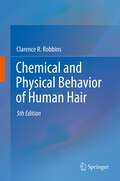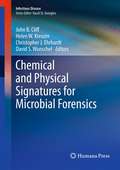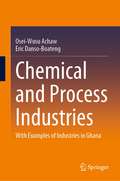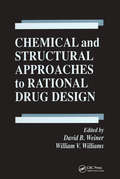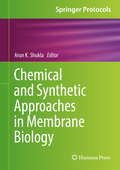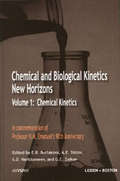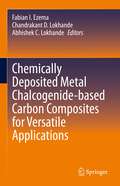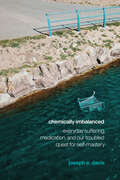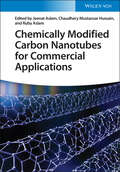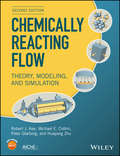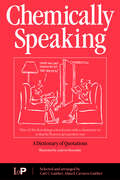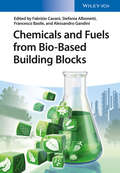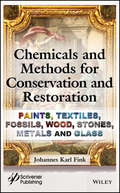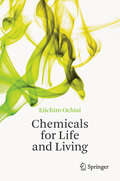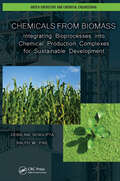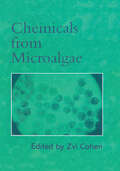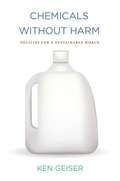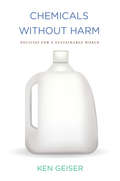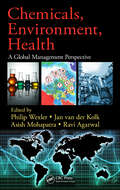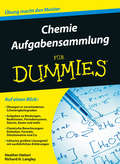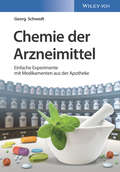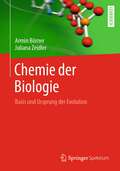- Table View
- List View
Chemical and Physical Behavior of Human Hair
by Clarence R. RobbinsHuman hair is the subject of a remarkably wide range of scientific investigations. Its chemical and physical properties are of importance to the cosmetics industry, forensic scientists and to biomedical researchers. The fifth edition of this book confirms its position as the definitive monograph on the subject. Previous editions were recognized as "concise and thorough" (Journal of the American Chemical Society), "an invaluable resource" (Canadian Forensic Science Society Journal), and "highly recommended" (Textile Research Journal). Chemical and Physical Behavior of Human Hair is a teaching guide and reference volume for cosmetic chemists and other scientists in the hair products industry, academic researchers studying hair and hair growth, textile scientists and forensic specialists. Features of the Fifth Edition: Recent advances in the classification and characterization of the different proteins and genes in IF and keratin associated proteins in human hair are described. The mechanism and incidence of hair growth and loss and hair density vs. age of males & females are described for Asians, Caucasians and Africans in different scalp regions. Details of hair surface lipids and cuticle membranes provide a better understanding of the surface and organization of the CMC and its involvement in stress strain is presented. Recent evidence demonstrates a more bilateral structure in curly hair and a more concentric arrangement of different cortical proteins in straighter hair. SNPs involved in hair form (curl and coarseness) and pigmentation and genes in alopecia and hair abnormalities are described. The latest biosynthetic scheme for hair pigments and structures for these and the different response of red versus brown-black pigments to photodegradation is described.A new method for curvature on 2,400 persons from different countries and groups is used to assign curvature throughout this book. Additional data for age and effects on diameter, ellipticity, elastic modulus, break stress and other parameters are presented with much larger data sets featuring statistical analyses. Hair conditioning, strength, breakage, split ends, flyaway, shine, combing ease, body, style retention, manageability and feel parameters are defined and described. A new section of different life stages by age groups considering collective and individual changes in hair fiber properties with age and how these affect assembly properties.
Chemical and Physical Signatures for Microbial Forensics (Infectious Disease)
by Helen W. Kreuzer David S. Wunschel John B. Cliff Christopher J. EhrhardtCombining the disciplines of biological, physical and chemical science, microbial forensics has a rapidly rising profile in a world increasingly troubled by the threat of 'biocrime' and 'bioterrorism'. This valuable resource is a major addition to a body of literature reckoned to lack sufficient breadth. It presents a variety of phenotypic and trace signature methodologies associated with cultured microorganisms that, despite being genetically identical, may be characterized by differing cultural environments. One of the central challenges faced by those working in this field is the sheer diversity of potentially harmful agents, which in themselves total more than 1000 viruses, bacteria, fungi and protozoan parasites. Their numerous additional variants render the process of 'fingerprinting' biological agents notoriously difficult, especially when the limitations of genetic analysis are factored in. Attribution of crime is relatively easy through human DNA, but lacking the genetic individuation of humans and animals, microbial forensics has to complement phylogenetic techniques with chemical and physical ones. In the best case, genetic analysis in the 'biocrime' sector can exclude sources, narrow the population of possible sources and support associations with potential sources. To complement these genetic techniques, chemical and physical methods can be used to compare 'signatures' imparted to microbial samples by environments in which they are grown and processed. Collating a range of microbiological fingerprinting techniques in one volume, and covering everything from statistical analysis to laboratory protocols, this publication furthers the aim of forensic investigators who need robust and legally admissible forensic evidence to present in a courtroom.
Chemical and Process Industries: With Examples of Industries in Ghana
by Osei-Wusu Achaw Eric Danso-BoatengThis textbook presents a thorough overview of chemical and process industries. It describes the standard technologies and the state of the industries and the manufacturing processes of specific chemical and allied products. It includes examples of industries in Ghana, highlighting the real-world applications of these technologies.The book introduces new developments in the processes in chemical industry, focuses on the technology and methodology of the processes and the chemistry underlying them. It offers guidance on operating of processing units. Furthermore, it includes sections on safety and environmental pollution control in industry.With a pedagogical and comprehensive approach, utilizing illustrations and tables, this book provides students in chemical engineering and industrial chemistry with a concise and up-to-date overview of this diverse subject.
Chemical and Structural Approaches to Rational Drug Design (Handbooks In Pharmacology And Toxicology Ser. #14)
by David B. Weiner; William B. WilliamsThis book is the first to provide both a broad overview of the current methodologies being applied to drug design and in-depth analyses of progress in specific fields. It details state-of-the-art approaches to pharmaceutical development currently used by some of the world's foremost laboratories. The book features contributors from a variety of fields, new techniques, previously unpublished data, and extensive reference lists.
Chemical and Synthetic Approaches in Membrane Biology (Springer Protocols Handbooks)
by Arun K. ShuklaThis practical volume brings together a broad range of topics related to membrane biology research with particular emphasis on novel approaches, technology platforms, and emerging tools in this area of study. Beginning with chapters pertaining to artificial or designer membrane mimetics that can be utilized for in vitro studies of membrane-lipid interactions, it then continues by covering the approaches and methodologies to directly investigate membrane protein structure, localization, and dynamics. Written for the Springer Protocols Handbooks series, this collection focuses on in-depth, hands-on protocols from experts in the field. Authoritative and cutting-edge, Chemical and Synthetic Approaches in Membrane Biology serves as an ideal guide to researchers investigating the vital properties of cellular membranes.
Chemical kinetics
by E. Yu KharitonovaThe volume is devoted to the problem of chemical kinetics on modern level. The book includes information on chemical physics of nanocomposites, degradation, stabilization and flammability of polymeric materials as well as free radical mechanism of oxidation of organic compounds, thermostability, mechanism of action of catalytical systems and inhibi
Chemically Active
by Vicki CobbFun scientific experiments that can be practiced in your home kitchen with simple materials available at your local drug & hardware stores.
Chemically Deposited Metal Chalcogenide-based Carbon Composites for Versatile Applications
by Fabian I. Ezema Chandrakant D. Lokhande Abhishek C. LokhandeThis book satisfies the interest and curiosity of beginners in thin film electrode preparations, characterizations, and device making, while providing insight into the area for experts. The considerable literature on ‘metal chalcogenides based carbon composites and their versatile applications’ reflect its importance for research and demonstrate how it’s now reached a level where the timely review is necessary to understand the current progress and recent trends and future opportunities. In the book, the authors examine recent advances in the state-of-the-art fabrication techniques of metal sulfide based carbon composites along with their working mechanisms, associated issues/solutions, and possible future are discussed. In addition, detailed insight into the properties and various applications including principles, design, fabrication, and engineering aspects are further discussed.
Chemically Imbalanced: Everyday Suffering, Medication, and Our Troubled Quest for Self-Mastery
by Joseph E. DavisA study of how ordinary people deal with everyday problems through self-mastery and mental health care practices.Everyday suffering—those conditions or feelings brought on by trying circumstances that arise in everyone’s lives—is something that humans have grappled with for millennia. But the last decades have seen a drastic change in the way we approach it. In the past, a person going through a time of difficulty might keep a journal or see a therapist, but now the psychological has been replaced by the biological: instead of treating the heart, soul, and mind, we take a pill to treat the brain.Chemically Imbalanced is a field report on how ordinary people dealing with common problems explain their suffering, how they’re increasingly turning to the thin and mechanistic language of the “body/brain,” and what these encounters might tell us. Drawing on interviews with people dealing with struggles such as underperformance in school or work, grief after the end of a relationship, or disappointment with how their life is unfolding, Joseph E. Davis reveals the profound revolution in consciousness that is underway. We now see suffering as an imbalance in the brain that needs to be fixed, usually through chemical means. This has rippled into our social and cultural conversations, and it has affected how we, as a society, imagine ourselves and envision what constitutes a good life. Davis warns that what we envision as a neurological revolution, in which suffering is a mechanistic problem, has troubling and entrapping consequences. And he makes the case that by turning away from an interpretive, meaning-making view of ourselves, we thwart our chances to enrich our souls and learn important truths about ourselves and the social conditions under which we live.Praise for Chemically Imbalanced“Chemically Imbalanced is an excellent addition to the works in social sciences and humanities that examine the distress of ordinary Americans from the second half of the twentieth century onward, a period when commercialized pills and the psychology-based notion of self-improvement entered the minds of Americans.” —Metascience“Chemically Imbalanced raises important questions, offers new insight into the power and reach of the biomedical model and neurobiological thinking, and I highly recommend it. I encourage readers to assign it, especially in graduate-level mental health and illness classes—or any class looking for a discussion on people’s experiences with suffering and the broad impacts of biomedical thinking and treatment.” —Social Forces
Chemically Modified Carbon Nanotubes for Commercial Applications
by Chaudhery Mustansar Hussain Jeenat Aslam Ruby AslamChemically Modified Carbon Nanotubes for Commercial Applications Discover the go-to handbook for developers and application-oriented researchers who use carbon nanotubes in real products Carbon nanotubes have held much interest for researchers since their discovery in 1991. Due to their low mass density, large aspect ratio, and unique physical, chemical, and electronic properties, they provide a fertile ground for innovation in nanoscale applications. The development of chemical modifications that can enhance the poor dispersion of carbon nanotubes in solvents and improve interactions with other materials have enabled extensive industrial applications in a variety of fields. As the chemistry of carbon nanotubes and their functionalization becomes better understood, Chemically Modified Carbon Nanotubes for Commercial Applications presents the most recent developments of chemically modified carbon nanotubes and emphasizes the broad appeal for commercial purposes along many avenues of interest. The book reviews their already realized and prospective applications in fields such as electronics, photonics, separation science, food packaging, environmental monitoring and protecting, sensing technology, and biomedicine. By focusing on their commercialization prospects, this resource offers a unique approach to a significant and cutting-edge discipline. In Chemically Modified Carbon Nanotubes for Commercial Applications readers will also find: Case studies that emphasize the information presented in each chapter Each chapter includes important websites and suggested reading materials Discussion of current applications of the relevant methodologies in every chapter A look at future perspectives in each application area to highlight the scope for next steps within the industry Chemically Modified Carbon Nanotubes for Commercial Applications is a valuable reference for material scientists, chemists (especially those focused on environmental concerns), and chemical and materials engineering scientists working in R&D and academia who want to learn more about chemically modified carbon nanotubes for various scalable commercial applications. It is also a useful resource for a broad audience: anyone interested in the fields of nanomaterials, nanoadsorbents, nanomedicine, bioinspired nanomaterials, nanotechnology, nanodevices, nanocomposites, biomedical application of nanomaterials, nano-engineering, and high energy applications.
Chemically Reacting Flow: Theory, Modeling, and Simulation
by Robert J. Kee Michael E. Coltrin Peter Glarborg Huayang ZhuA guide to the theoretical underpinnings and practical applications of chemically reacting flow Chemically Reacting Flow: Theory, Modeling, and Simulation, Second Edition combines fundamental concepts in fluid mechanics and physical chemistry while helping students and professionals to develop the analytical and simulation skills needed to solve real-world engineering problems. The authors clearly explain the theoretical and computational building blocks enabling readers to extend the approaches described to related or entirely new applications. New to this Second Edition are substantially revised and reorganized coverage of topics treated in the first edition. New material in the book includes two important areas of active research: reactive porous-media flows and electrochemical kinetics. These topics create bridges between traditional fluid-flow simulation approaches and transport within porous-media electrochemical systems. The first half of the book is devoted to multicomponent fluid-mechanical fundamentals. In the second half the authors provide the necessary fundamental background needed to couple reaction chemistry into complex reacting-flow models. Coverage of such topics is presented in self-contained chapters, allowing a great deal of flexibility in course curriculum design. • Features new chapters on reactive porous-media flow, electrochemistry, chemical thermodynamics, transport properties, and solving differential equations in MATLAB • Provides the theoretical underpinnings and practical applications of chemically reacting flow • Emphasizes fundamentals, allowing the analyst to understand fundamental theory underlying reacting-flow simulations • Helps readers to acquire greater facility in the derivation and solution of conservation equations in new or unusual circumstances • Reorganized to facilitate use as a class text and now including a solutions manual for academic adopters Computer simulation of reactive systems is highly efficient and cost-effective in the development, enhancement, and optimization of chemical processes. Chemically Reacting Flow: Theory, Modeling, and Simulation, Second Edition helps prepare graduate students in mechanical or chemical engineering, as well as research professionals in those fields take utmost advantage of that powerful capability.
Chemically Speaking: A Dictionary of Quotations
by Carl C. Gaither Alma E. Cavazos-GaitherIn these days of ever-increasing specialization, it is important to gain a broad appreciation of scientific disciplines such as chemistry. With this in mind, Chemically Speaking: A Dictionary of Quotations contains the words and wisdom of several hundred scientists, writers, philosophers, poets, and academics. Some quotations are illustrated by amu
Chemicals and Fuels from Bio-Based Building Blocks
by Francesco Basile Stefania Albonetti Alessandro Gandini Fabrizio CavaniAn up-to-date and two volume overview of recent developments in the field of chemocatalytic and enzymatic processes for the transformation of renewable material into essential chemicals and fuels. Experts from both academia and industry discuss catalytic processes currently under development as well as those already in commercial use for the production of bio-fuels and bio-based commodity chemicals. As such, they cover drop-in commodity chemicals and fuels, as well as bio-based monomers and polymers, such as acrylic acid, glycols, polyesters and polyolefins. In addition, they also describe reactions applied to waste and biomass valorization and integrated biorefining strategies. With its comprehensive coverage of the topic, this is an indispensable reference for chemists working in the field of catalysis, industrial chemistry, sustainable chemistry, and polymer synthesis.
Chemicals and Methods for Conservation and Restoration: Paintings, Textiles, Fossils, Wood, Stones, Metals, and Glass
by Johannes Karl FinkBefore the 1970s, most information concerning the conservation and restoration of paintings, wood, and archaeological artefacts were focused on the history of the artefacts, previous attempts of conservation, and the future use of these artefacts. The technical methods of how the restoration and conservation were made were dealt with only very briefly. Today, sophisticated methods of scientific analysis such as DNA are common place, and this encourages conservators and scientists to work together to work out the development of new methods for analysis and conservation of artefacts. This book focuses on the chemicals used for conservation and restoration of various artefacts in artwork and archaeology, as well as special applications of these materials. Also the methods used, both methods for cleaning, conservation and restoration, as well as methods for the analysis of the state of the respective artefacts. Topics include oil paintings, paper conservation, textiles and dyes for them, archaeological wood, fossils, stones, metals and metallic coins, and glasses, including church windows.
Chemicals for Life and Living
by Eiichiro OchiaiChemicals often have a negative Image among the general public. But there is no material world or indeed human beings without chemicals. The material world is operated by chemicals. The title 'Chemicals for Life and Living' implies that the material world is staged and played by chemicals. The book consists of five parts and an appendix. Part 1 - Essentials for life; Part 2 - Enhancing health; Part 3 - For the fun of life; Part 4 - Chemistry of the universe and earth, and Part 5 - Some negative effects of chemicals. The appendix gives a brief summary of what chemistry is all about, including a short chapter of chemical principles. No quantitative calculations are included in this book so that it is appealing for everyone - not just chemists.
Chemicals from Biomass: Integrating Bioprocesses into Chemical Production Complexes for Sustainable Development (Green Chemistry and Chemical Engineering)
by Ralph W. Pike Debalina SenguptaChemicals from Biomass: Integrating Bioprocesses into Chemical Production Complexes for Sustainable Development helps engineers optimize the development of new chemical and polymer plants that use renewable resources to replace the output of goods and services from existing plants. It also discusses the conversion of those existing plants into faci
Chemicals from Microalgae
by Zvi CohenThe production of chemicals from microalgae is becoming a significant area of biological research. Chemicals from Microalgae seeks to cover the various aspects that relate to the use of microalgae as a source of chemicals. The chapters discuss the occurrence and physiological role of these chemicals and concentrates on the methods aimed at enhancin
Chemicals in the Food Industry: Toxicological Concerns and Safe Use (SpringerBriefs in Molecular Science)
by Michele Barone Rachid ChaibThis book addresses the use and management of chemicals in the food and beverage industry. The authors explore the use of chemicals as food additives and sanitizers, and provide an overview of their toxicological characterisation with regard to the employees who handle them, and to consumers. In addition, the authors pay special attention to the safe and reliable management of chemicals in the food production and packaging areas, and in quality control laboratories. Topics such as toxicological risks, the importance of labelling, technical and material safety data sheets, risk categories (e.g. fire, explosion, unforeseen chemical reactions, etc.), safe use of hazardous chemicals, prevention procedures, and emergency planning in laboratories and industrial areas are also covered. In closing, readers will learn more about the future behaviour of food-production workers regarding chemical handling and approved uses, especially in light of the recent REACH obligations.Given its scope, the book will appeal not only to researchers interested in food production, food safety, risk prevention and public health, but also to professionals involved in quality control and risk assessment in the food and beverage industry.
Chemicals without Harm
by Ken GeiserToday, there are thousands of synthetic chemicals used to make our clothing, cosmetics, household products, electronic devices, even our children's toys. Many of these chemicals help us live longer and more comfortable lives, but some of these highly useful chemicals are also persistent, toxic, and dangerous to our health and the environment. For fifty years, the conventional approach to hazardous chemicals has focused on regulation, barriers, and protection. In Chemicals without Harm, Ken Geiser proposes a different strategy, based on developing and adopting safer alternatives to hazardous chemicals rather than focusing exclusively on controlling them. Geiser reviews past government policies focused on controlling chemicals, describes government initiatives outside the United States that have begun to implement a more sustainable chemical policy, and offers an overview of the chemicals industry and market. He develops a safer chemicals policy framework that includes processes for characterizing, classifying, and prioritizing chemicals; generating and using new chemical information; and promoting transitions to safer chemicals. The shift in strategy described by Geiser will require broad changes in science, the chemicals economy, and government policy. Geiser shows that it is already beginning, identifying an emerging movement of scientists, corporate managers, environmental activists, and government leaders who are fashioning a new, twenty-first-century approach to chemicals.
Chemicals without Harm
by Ken GeiserToday, there are thousands of synthetic chemicals used to make our clothing, cosmetics, household products, electronic devices, even our children's toys. Many of these chemicals help us live longer and more comfortable lives, but some of these highly useful chemicals are also persistent, toxic, and dangerous to our health and the environment. For fifty years, the conventional approach to hazardous chemicals has focused on regulation, barriers, and protection. In Chemicals without Harm, Ken Geiser proposes a different strategy, based on developing and adopting safer alternatives to hazardous chemicals rather than focusing exclusively on controlling them. Geiser reviews past government policies focused on controlling chemicals, describes government initiatives outside the United States that have begun to implement a more sustainable chemical policy, and offers an overview of the chemicals industry and market. He develops a safer chemicals policy framework that includes processes for characterizing, classifying, and prioritizing chemicals; generating and using new chemical information; and promoting transitions to safer chemicals. The shift in strategy described by Geiser will require broad changes in science, the chemicals economy, and government policy. Geiser shows that it is already beginning, identifying an emerging movement of scientists, corporate managers, environmental activists, and government leaders who are fashioning a new, twenty-first-century approach to chemicals.
Chemicals without Harm: Policies for a Sustainable World (Urban and Industrial Environments)
by Ken GeiserA proposal for a new chemicals strategy: that we work to develop safer alternatives to hazardous chemicals rather than focusing exclusively on controlling them.Today, there are thousands of synthetic chemicals used to make our clothing, cosmetics, household products, electronic devices, even our children's toys. Many of these chemicals help us live longer and more comfortable lives, but some of these highly useful chemicals are also persistent, toxic, and dangerous to our health and the environment. For fifty years, the conventional approach to hazardous chemicals has focused on regulation, barriers, and protection. In Chemicals without Harm, Ken Geiser proposes a different strategy, based on developing and adopting safer alternatives to hazardous chemicals rather than focusing exclusively on controlling them. Geiser reviews past government policies focused on controlling chemicals, describes government initiatives outside the United States that have begun to implement a more sustainable chemical policy, and offers an overview of the chemicals industry and market. He develops a safer chemicals policy framework that includes processes for characterizing, classifying, and prioritizing chemicals; generating and using new chemical information; and promoting transitions to safer chemicals. The shift in strategy described by Geiser will require broad changes in science, the chemicals economy, and government policy. Geiser shows that it is already beginning, identifying an emerging movement of scientists, corporate managers, environmental activists, and government leaders who are fashioning a new, twenty-first-century approach to chemicals.
Chemicals, Environment, Health: A Global Management Perspective
by Ravi Agarwal Philip Wexler Jan van der Kolk Asish MohapatraThe past 40 years have seen a phenomenal growth in globally oriented public and private initiatives related to chemical and environmental issues. The groundbreaking 1972 United Nations Conference on the Human Environment held in Stockholm was the event responsible for initiating framework for global environmental policies, including those addressin
Chemie Aufgabensammlung für Dummies (Für Dummies)
by Richard H. Langley Heather HattoriEtwas lernen ist eine Sache, es später umzusetzen noch einmal eine ganz andere. Aber keine Sorge, dieses Buch enthält ausreichend Übungsaufgaben, um verschiedene Aufgabentypen kennenzulernen und erfolgreich zu lösen. Die Themengebiete reichen von der Einheitenumrechnung über Bindungen, Reaktionen und Periodensystem bis zu Säuren, Basen, Energie und Co. Ausführliche Erläuterungen Lösungen ermöglichen es, auch schwierige Aufgaben nachzuvollziehen und so endlich zu verstehen. Die nächste Prüfung kann also kommen.
Chemie der Arzneimittel: Einfache Experimente mit Medikamenten aus der Apotheke
by Georg SchwedtWer hat sich beim Blick in die Hausapotheke nicht schon einmal gefragt, wie all die Pillen, Cremes und Tinkturen eigentlich wirken? Die Antwort kann jeder selbst herausfinden, denn die Chemie hinter der Arzneimittelwirkung lässt sich mithilfe der hier beschriebenen Experimente auf verblüffend einfache Weise zeigen. Im ersten Teil werden Arzneimittel vorgestellt, die als Hauptwirkstoffe anorganische Substanzen enthalten und zum Teil schon seit Jahrhunderten in Gebrauch sind. Im zweiten Teil werden Arzneimittel mit organischen Wirkstoffen wie z. B. Aspirin oder Paracetamol untersucht. Die Herstellung von Arzneien aus Wirkstoffen und Begleitstoffen wird im dritten Teil anhand unterschiedlicher Arzneiformen wie Tinkturen, Salben und Pillen beschrieben. Mit den hier vorgestellten Verfahren und Rezepten kann jeder zum Hobby-Apotheker werden und eigene Medikamente herstellen - Wirkung garantiert! Die mehr als 80 Experimente wurden vom Autor eigens für dieses Buch entwickelt und sind mit einfachsten Mitteln und Geräten durchführbar. Die zur Durchführung der Versuche nötigen Arzneipräparate sind in Apotheken und Drogeriemärkten rezeptfrei erhältlich.
Chemie der Biologie: Basis und Ursprung der Evolution
by Armin Börner Juliana ZeidlerLebewesen unterscheiden sich durch ihre chemische Basis. Somit ist das Wissen um die Eigenschaften der Elemente und die Wechselwirkungen der daraus entstehenden Verbindungen Voraussetzung für das Verständnis der Biologie. Die Chemie beantwortet die Fragen, warum unter den über 100 Elementen des Periodensystems (PSE) der Kohlenstoff und nicht das Silicium das dominierende Element in der Biologie ist und warum Edelmetalle, wie Gold und Silber, keine Rolle spielen. Das PSE gibt Auskunft darüber, warum die Phosphorsäure und nicht die Schwefelsäure als Brücke in den Polynucleinsäuren fungiert und warum sich die DNA aus der RNA entwickeln musste. Gleichzeitig macht nur die Chemie deutlich, warum die D-Glucose so zentral beim Aufbau von Biopolymeren wie Cellulose und Glycogen ist und weshalb der Citratzyklus in sich logisch geschlossen und alternativlos ist. Biochemie ist ebenfalls eine Synthesechemie, die sich von der „menschengemachten“ Synthesechemie „nur“ hinsichtlich der Rahmenbedingungen unterscheidet. Aus der Vielzahl der Elemente des PSE und der fast unendlichen Anzahl von chemischen Verbindungen werden einzelne selektiert. Die Selektion erfolgt aufgrund der Umweltbedingungen auf der Erde, wie moderate Temperaturen, vorzugsweise Atmosphärendruck, Lösungsmittel Wasser und als primärer Reaktionspartner Sauerstoff. Es wird die Hypothese entwickelt, dass der Leitgedanke der modernen Biologie, die Evolutionstheorie, ihre Wurzeln in der zugrundeliegenden Chemie hat. Damit wird der Darwinismus vom biologischen Kopf auf die chemischen Füße gestellt. Zum Beispiel ist die Wirkung von Phenolen als Radikalfänger a priori chemisch, ehe daraus biologische Phänomene als Distinktionsunterschiede bei farbigen Blütenpflanzen evolvieren konnten. Das Buch entwickelt eine völlig neue, chemiezentrierte Sicht auf die „belebte Natur“ und fordert zu einer veränderten, biologisch orientierten Chemiedidaktik in Schulen und Universitäten heraus.
